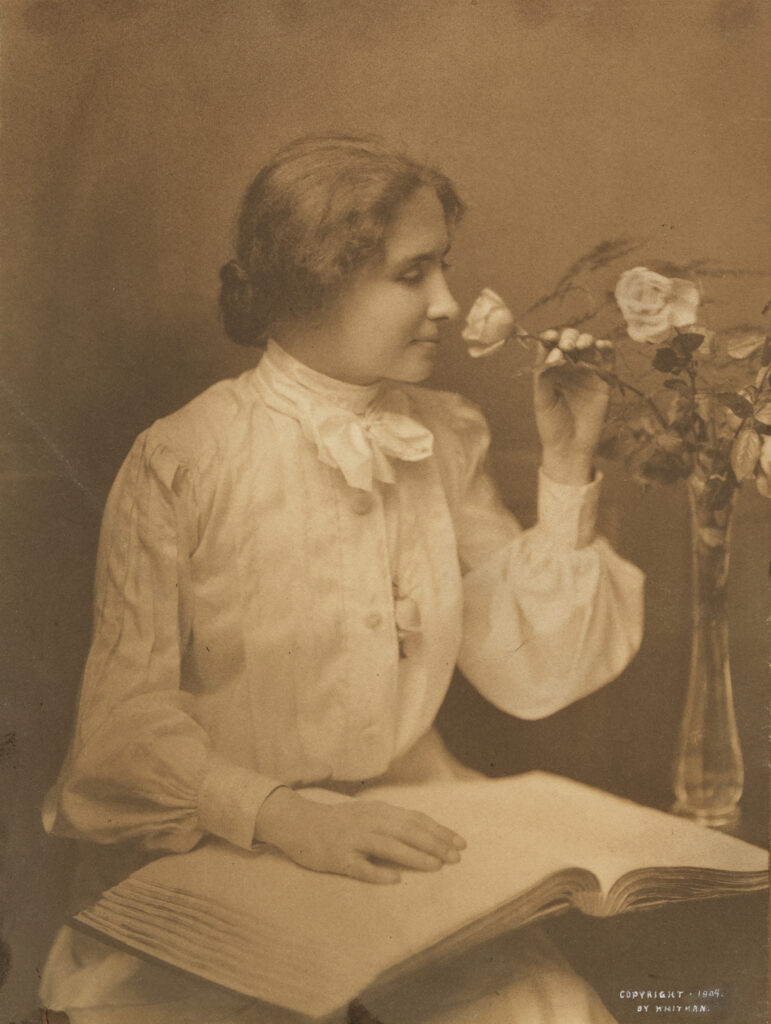Two Letters of Helen Keller[1]
By Helen Keller
Annotations by Celia Hawley

Washington, D.C.
TO MR. WILLIAM WADE South Boston, Mass., Nov. 20, 1889. My Dear Mr. Wade:—I have just received a letter from my mother, telling me that the beautiful mastiff puppy you sent me had arrived in Tuscumbia safely.[2] Thank you very much for the nice gift. I am very sorry that I was not at home to welcome her; but my mother and my baby sister will be very kind to her while her mistress is away. I hope she is not lonely and unhappy. I think puppies can feel very home-sick, as well as little girls. I should like to call her Lioness, for your dog. May I? I hope she will be very faithful,—and brave, too. I am studying in Boston, with my dear teacher. I learn a great many new and wonderful things. I study about the earth, and the animals, and I like arithmetic exceedingly. I learn many new words, too. EXCEEDINGLY is one that I learned yesterday. When I see Lioness I will tell her many things which will surprise her greatly. I think she will laugh when I tell her she is a vertebrate, a mammal, a quadruped; and I shall be very sorry to tell her that she belongs to the order Carnivora. I study French, too. When I talk French to Lioness I will call her mon beau chien. Please tell Lion that I will take good care of Lioness. I shall be happy to have a letter from you when you like to write to me. From your loving little friend, HELEN A. KELLER. P.S. I am studying at the Institution for the Blind. H. A. K. [3]
TO DR. OLIVER WENDELL HOLMES South Boston, Mass., April, 1891 Dear Dr. Holmes:—Your beautiful words about spring have been making music in my heart, these bright April days. I love every word of "Spring" and "Spring Has Come." I think you will be glad to hear that these poems have taught me to enjoy and love the beautiful springtime, even though I cannot see the fair, frail blossoms which proclaim its approach, or hear the joyous warbling of the home-coming birds. But when I read "Spring Has Come," lo! I am not blind any longer, for I see with your eyes and hear with your ears. Sweet Mother Nature can have no secrets from me when my poet is near. I have chosen this paper because I want the spray of violets in the corner to tell you of my grateful love. I want you to see baby Tom, the little blind and deaf and dumb child who has just come to our pretty garden. He is poor and helpless and lonely now, but before another April education will have brought light and gladness into Tommy's life. If you do come, you will want to ask the kind people of Boston to help brighten Tommy's whole life. Your loving friend, HELEN KELLER.
Keller, Helen. “to mr. William Wade,” “To Dr. Oliver Wendell Holmes.” Personal correspondence, Courtesy American Federation for the blind.
[1] Helen was only 9 and 11 years old, respectively, when she wrote these letters. Newspapers in America and Europe had already celebrated her, and she had met a number of well-known people of the period. At the age of eight, she visited President Grover Cleveland at the White House. (See Helen Keller: Selected Writings)
[2] Tuscumbia, Alabama is Helen Keller’s birthplace. Listed on the National Register of Historic Places, it is also the location of the Alabama Music Hall of Fame.
[3] Helen wrote this correspondence by hand. She learned to write using paper with a grooved board behind it, an arduous and time-consuming process. Having learned her first letters and words through manual finger positions, she would eventually learn and have access to standard Braille, a system not adopted in the U.S. until 1918. (See Helen Keller: Selected Writings)
Contexts
Helen was born with both sight and hearing, as detailed in the Helen Keller Biography. She and her teacher, Anne Sullivan, were lifelong companions. Anne’s life was alsofull of challenges to overcome. Born in 1866 to a family who left Ireland due to the Great Famine, Anne contracted a chronic eye disease at age five. She and her brother Jimmy were abandoned to a poor house as children after their mother’s death, and her admittance to the Perkins Institute changed her life.
Resources for Further Study
- Dr. Holmes’ reply to Keller’s letter
- Helen Keller Had Impeccable Handwriting: See a Collection of Her Childhood Letters
- How Helen Keller Learned to Write
- Helen Keller’s Life and Impact
- About the Book: The Story of My Life by Helen Keller
Contemporary Connections
The Perkins School for the Blind in Watertown, Massachusetts, is the oldest school for the blind in the U.S. The school now uses the Expanded Core Curriculum (ECC), a disability-specific set of skills that focuses on many avenues to independence.